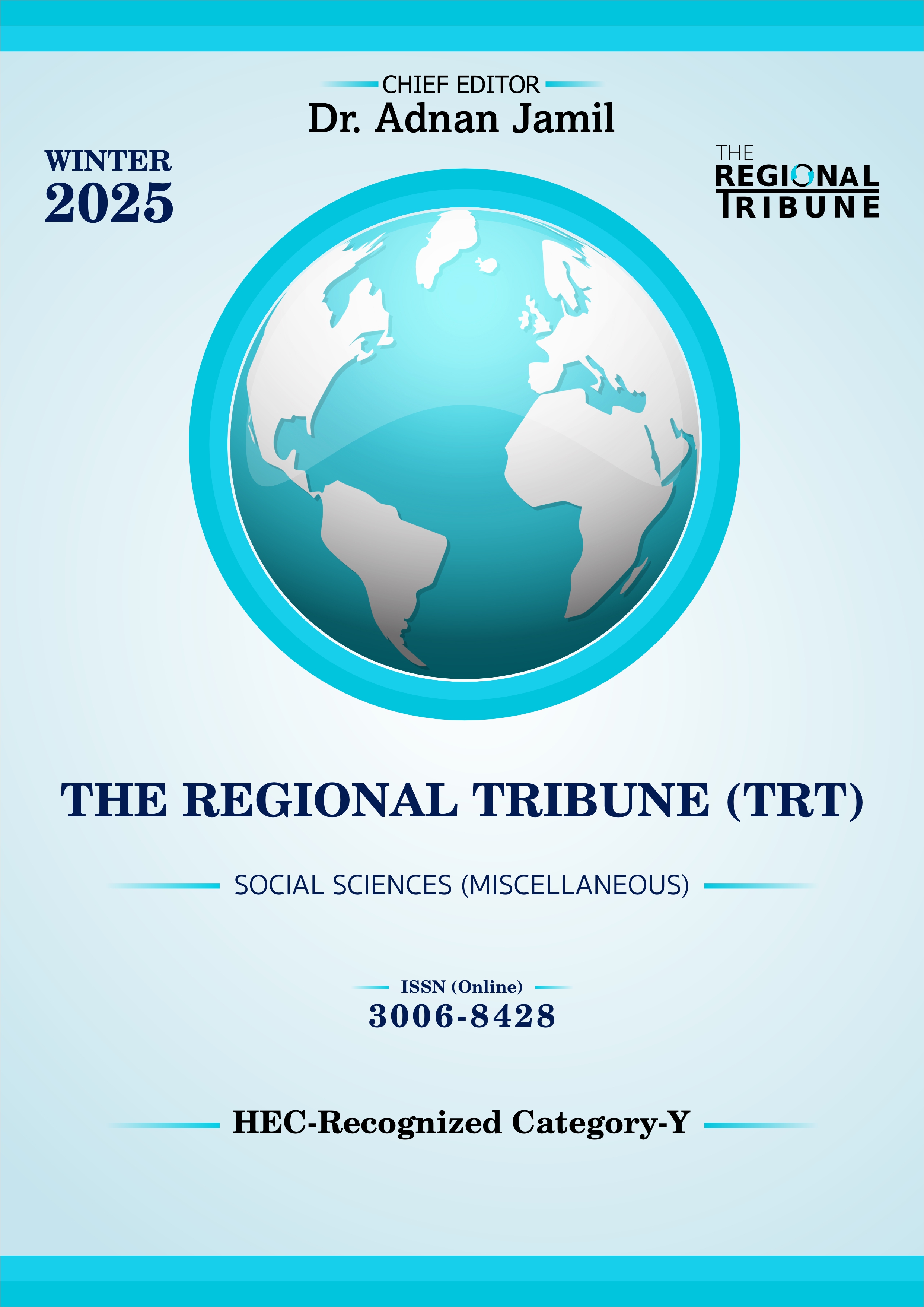Exploring Stereotypes: An Examination of Social and Cultural Stereotypes through Discourse in Films with Case Study of “Zindagi Tamasha”
DOI:
https://doi.org/10.63062/trt/WR25.066Keywords:
Pakistani Cinema, Zindagi Tamasha,, Film Analysis, Stereotypes, Cultural Representation, Societal Norms, GenderAbstract
Stereotypes are prevalent and entrenched societal attitudes that emerge in various forms. Over the years, films have significantly contributed to the portrayal and reinforcement of these biases. This study examines, via comprehensive cinematic analysis, the depiction of many stereotypes in the Pakistani film "Zindagi Tamasha". This study uses concepts from cultural studies to examine how the film challenges conventional beliefs, engages with societal norms, and initiates discourse on Pakistani culture. The study employs an interdisciplinary approach, recognizing that various facets of our identity—such as gender, religion, and financial status—shape our beliefs. Thoroughly analyzing the narrative, language, imagery, and character development the researcher facilitates the assessment of the picture and its societal significance. Two primary ethical concerns are: adherence to regulations about appropriate usage and the acknowledgment of diverse cultural backgrounds. The study seeks to elucidate how "Zindagi Tamasha" contests prevailing notions, so contributing to the continuing discourse on cultural representation in Pakistani cinema. This study examines the portrayal of multiple stereotypes in the Pakistani film "Zindagi Tamasha" through a wide-ranging cinematic analysis, utilizing Teun A. van Dijk's theoretical framework on discourse and social representation. By applying impressions from cultural studies, the research explores how the film challenges conventional beliefs, engages with societal norms, and initiates discourse on Pakistani culture. Rahat's distinctive movement, particularly his dancing, directs our attention to the influence of language and discourse on our comprehension of moral concepts.
References
Berger, P. L., & Luckmann, T. (1966). The Social Construction of Reality: A Treatise in the Sociology of Knowledge. Anchor Book.
Borish, D., Cunsolo, A., Mauro, I., Dewey, C., & Harper, S. L. (2021). Moving images, Moving Methods: Advancing Documentary Film for Qualitative Research. International Journal of Qualitative Methods, 20. https://doi.org/10.1177/16094069211013646
Dickey, S., & Dudrah, R. (2010). South Asian cinemas: Widening the lens. South Asian Popular Culture, 8(3), 207–212. https://doi.org/10.1080/14746689.2010.501539
Dines, G. (1995). Gender, Race, and Class in Media: A Critical Reader. Sage Publications.
Gerbner, G., Gross, L., Morgan, M., & Signorielli, N. (1982). Charting the mainstream: Television's contributions to political orientations. Journal of Communication, 32(2), 100–127. https://doi.org/10.1111/j.1460-2466.1982.tb00500.x
Gergen, K. J., & Marlowe, D. (1971). The Concept of Self Holt, Rinehart and Winston. United States Of America.
Hall, S. (1997). Representation: Cultural Representation and Signifying Practices. Sage.
Hooks, B. (1992). Black Looks: Race and Representation. Routledge.
Kuhn, A. (1982). Women's Pictures: Feminism and Cinema. Routledge.
Lu, Z. (2023). How do Films Reflect our Societies Today? An Analysis of Films and Film Genres. Communication Society and Media, 6(4), p69. https://doi.org/10.22158/csm.v6n4p69
Maheshwari, L. (2022, February 24). How Bollywood stereotypes the West. https://www.bbc.com/culture/article/20170922-how-bollywood-stereotypes-the-west
Metz, C. (1974). Film Language: A Semiotics of the Cinema. University of Chicago Press.
Mulvey, L. (1975). Visual Pleasure and Narrative Cinema. Screen, 16(3), 6–18.
Nair. N (2017) ‘Bik Gayi Hai Gormint’ Auntie’s Son Says The Viral Video Destroyed The Family’s Social Image. India.com
Parveen, S., Anam Ikhtiar, & Iqbal, A. (2023). Unmasking the Inner Psyche: A Dual Approach to Understand “Zindagi Tamsha” (Circus of Life) through Semiotics and Psychoanalysis. Global Digital & Print Media Review, VI(I), 281–289. https://doi.org/10.31703/gdpmr.2023(vi-i).22
Pongpan, N. K. (2023). GANGUBAI KATHIAWADI (2022): THE EMPOWERING RESISTANCE. Literature and Literacy, 1(2), 81–94. https://doi.org/10.21831/litlit.v1i2.26
Saleem, S. (2020). 5 Pakistani Films That Left Us Thinking About Its Strong Message. Diva Magazine. https://www.divaonline.com.pk/5-pakistani-films-that-left-us-thinking-about-its-strong-message/
Shan, A. A. (2023). Portrayal of Pakistan and Muslims Characters in the Bollywood (Indian) Film Industry [Master's thesis]. https://hj.diva-portal.org/smash/get/diva2:1875503/FULLTEXT01.pdf
Steiner, L. (2016). “Wrestling with the Angels”: Stuart Hall’s Theory and Method. Howard Journal of Communications, 27(2), 102–111. https://doi.org/10.1080/10646175.2016.1148649
Tajfel, H., & Turner, J. C. (1986). The social identity theory of intergroup behavior. In S. Worchel & W. G. Austin (Eds.), Psychology of intergroup relations (pp. 7- 24). Chicago, IL: Nelson-Hall.
Van Dijk’s, (2001). Framework Of Critical Discourse Analysis - The Lingwist. The Lingwist. https://thelingwist.net/van-dijks-framework-of-critical-discourse-analysis/#google_vignette
Downloads
Published
Issue
Section
License

This work is licensed under a Creative Commons Attribution-NonCommercial 4.0 International License.



